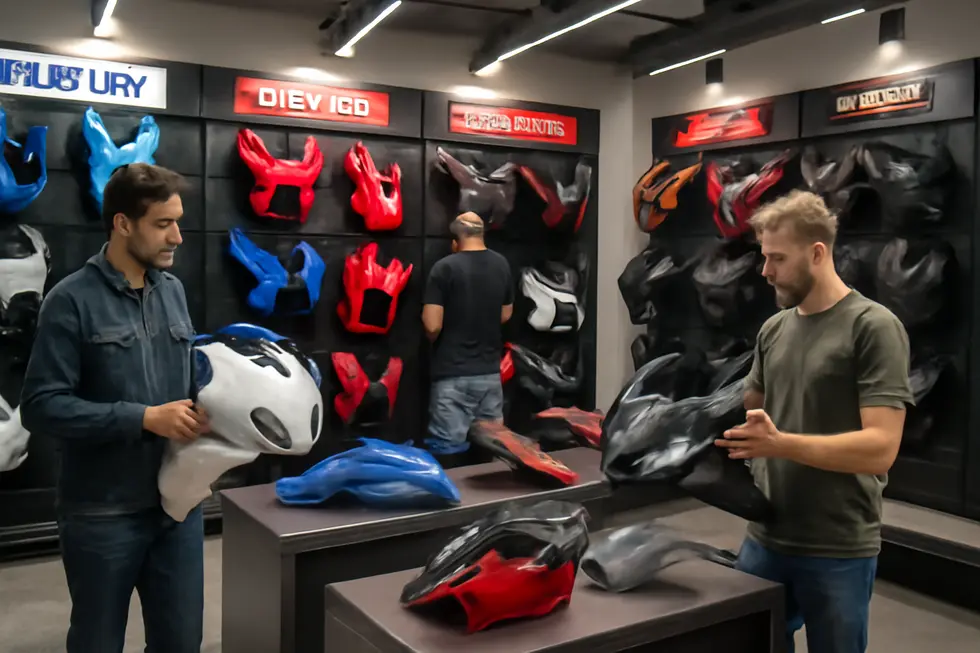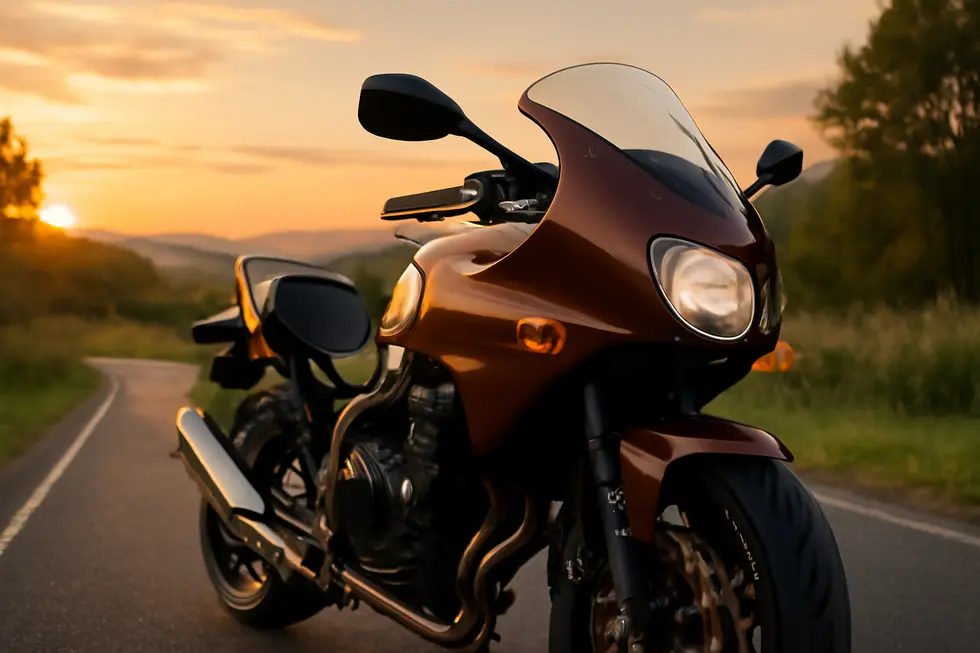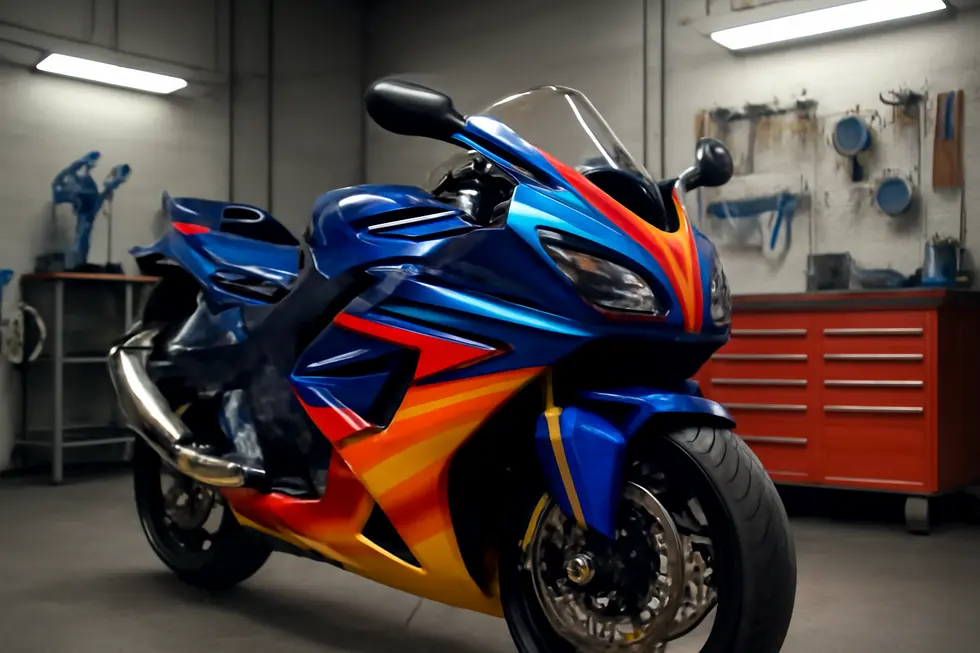Mastering the Front Fairing: Boost Performance and Rider Appeal on Your Motorcycle
August 23, 2025 | by summitfairings

Introduction
The front fairing on a motorcycle plays a pivotal role not only in enhancing aerodynamic efficiency but also in improving rider comfort and style—factors integral to motorcycle performance and market appeal. For business owners in the motorcycle industry, understanding these components is critical to offering superior products that meet both functional and aesthetic demands. This discussion delves into three essential facets: the aerodynamic and functionality advantages that improve speed and stability; the sophisticated materials and manufacturing techniques driving quality and durability; and finally, how front fairings protect riders while shaping the motorcycle’s visual identity. Together, these insights provide a comprehensive perspective to inform better product development, marketing, and customer satisfaction strategies.
Tables of Contents
Chapter 1: Aerodynamics and Functionality of the Front Fairing on a Motorcycle
- How Aerodynamic Forces Shape the Performance and Protection of Motorcycle Front Fairings
- How Front Fairing Design Enhances High-Speed Stability and Handling Precision
- Optimizing Airflow: Thermal Management and Cooling Efficiency Through Front Fairing Design
- Enhancing Rider Protection and Comfort through Advanced Aerodynamic Front Fairings
- Balancing Lightweight Materials and Structural Strength for Optimal Motorcycle Fairing Performance
Chapter 2: Materials and Manufacturing Processes Behind Motorcycle Front Fairings
- Choosing the Right Material: Balancing Strength, Weight, and Durability in Motorcycle Front Fairings
- Precision Injection Molding: Crafting Durable and Aerodynamic Motorcycle Front Fairings
- The Art of Finishing: Painting and Coating Techniques Elevating Front Fairings
- Advancing Sustainability: Eco-Friendly Materials and Circular Manufacturing in Motorcycle Front Fairings
- Cutting-Edge Materials and Manufacturing Techniques Elevating Motorcycle Front Fairings
Chapter 3: Rider Protection and Aesthetic Considerations of the Front Fairing on a Motorcycle
- Cutting-Edge Rider Safety Features and Striking Front Fairing Designs Enhancing Protection and Style
- Innovative Materials and Engineering Techniques Shaping Rider Safety and Style in Front Fairings
- How Aerodynamics Shapes Rider Safety and Visual Identity in Motorcycle Front Fairings
- Market Dynamics Shaping Rider Safety and Style in Motorcycle Front Fairings
- How Cultural Identity and Societal Norms Shape Front Fairing Design and Rider Protection
Chapter 1: Aerodynamics and Functionality of the Front Fairing on a Motorcycle
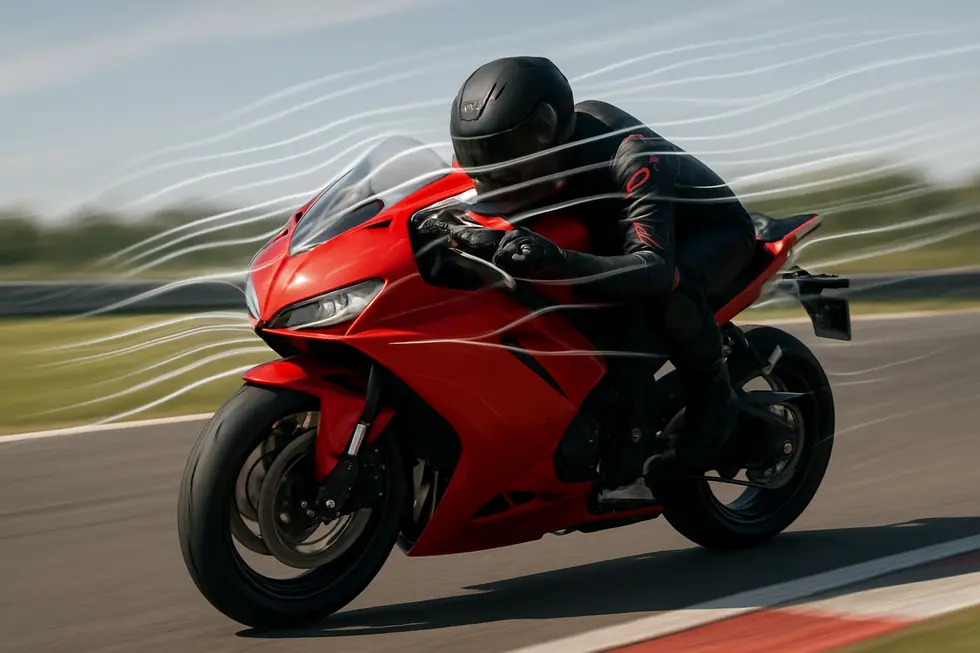
1. How Aerodynamic Forces Shape the Performance and Protection of Motorcycle Front Fairings
The front fairing of a motorcycle is a masterclass in aerodynamic engineering, designed to harmonize multiple forces that directly influence performance, stability, and rider comfort. At its core, the fairing streamlines airflow by directing air smoothly over the motorcycle and rider, dramatically reducing drag that otherwise saps speed and wastes energy. This is achieved through precisely contoured surfaces that shrink the frontal area facing the wind, limiting turbulent wake behind the bike and improving fuel efficiency and top-end velocity. But the fairing does far more than just trim air resistance. Integrated aerodynamic features such as winglets generate downforce, pressing the front tire firmly onto the road. This enhances traction and handling, especially during high-speed cornering and rapid directional shifts, thereby increasing rider confidence and control without adversely affecting airflow efficiency. Another critical role lies in airflow management for cooling. Strategically placed ducts channel fresh air through the engine’s radiators and oil coolers, ensuring that vital components remain within optimal temperature ranges even under sustained performance loads. These ducts are carefully designed to avoid adding drag while efficiently expelling heated air, which also helps reduce turbulence within the bike’s wake. Crosswind stability is another integral factor; the fairing’s shape and positioning minimize the destabilizing effects of side winds, preserving balance and decreasing rider fatigue during high-speed travel. Additionally, by creating an aerodynamic “bubble,” the fairing protects the rider against buffeting and harsh wind pressure, offering a more comfortable and safer ride. This blend of drag reduction, downforce, cooling efficiency, and rider shielding exemplifies how front fairings contribute significantly to motorcycle dynamics. For enthusiasts interested in exploring options that combine aerodynamic performance with style and durability, sources such as Summit Fairings offer a comprehensive guide to modern motorcycle fairings.
To understand real-world application of these principles, one can study production motorcycles famous for their fairing innovations, which demonstrate how aerodynamic design directly elevates speed, control, and rider safety at once[1].
2. How Front Fairing Design Enhances High-Speed Stability and Handling Precision
The front fairing of a motorcycle plays a pivotal role in elevating both stability and handling at high speeds by expertly managing airflow and aerodynamic forces. This streamlined bodywork reduces drag by smoothly channeling wind around the motorcycle and rider, minimizing turbulent air resistance that typically disrupts stability. By enveloping critical areas such as the front tire and frame, the fairing reduces aerodynamic buffeting, which translates to steadier rides even as speeds exceed typical street velocities.
Beyond drag reduction, modern front fairings incorporate features that generate downforce, pressing the tires more firmly into the road surface. This increase in grip is essential for maintaining control during fast straight-line runs and aggressive cornering maneuvers, where any loss of traction can be dangerous. Certain designs integrate winglets or double-profile wings to create measurable downforce without significantly increasing drag, allowing riders to push performance limits safely.
Handling is further refined through sophisticated airflow management around the front wheel and radiator. By reducing turbulent vortices formed in these regions, the fairing improves directional precision and enhances engine cooling simultaneously. Moreover, fairings designed with the leading edge positioned slightly rearward can mitigate the destabilizing effects of crosswinds, helping riders maintain control during rapid lane changes or windy conditions.
Material advancements contribute another layer of performance; lightweight composites such as carbon fiber lower the bike’s front-end weight, improving agility and reducing rider fatigue on long rides. This synergy of aerodynamic efficiency and functional design underscores the importance of a well-crafted front fairing for both race and street motorcycles.
For those interested in exploring how custom and aftermarket options can further refine your motorcycle’s aerodynamics and handling, detailed guides are available through resources like Explore the Best Motorcycle Fairings at Summit Fairings.
In essence, the front fairing is not merely a stylistic accessory but a critical component that molds airflow, enhances grip, and stabilizes the motorcycle in diverse high-speed scenarios, creating a safer, more controlled riding experience.
3. Optimizing Airflow: Thermal Management and Cooling Efficiency Through Front Fairing Design
The front fairing on a motorcycle serves a vital role not only in shaping aerodynamic performance but also in managing thermal conditions critical to the bike’s reliability and performance. By expertly directing airflow toward heat-intensive elements such as the engine, radiators, and oil coolers, the fairing enhances cooling without sacrificing aerodynamic integrity. This seamless integration ensures that cooling air is efficiently channeled through specialized intake vents positioned to maximize air volume and velocity. Equally important are strategically placed outlets that allow hot air to escape, preventing heat buildup around sensitive components.
Modern front fairings often incorporate aerodynamic appendages, such as winglets, that contribute to downforce while doubling as vents facilitating thermal scavenging. These features demonstrate an advanced design philosophy where aerodynamic stability and cooling performance are intertwined rather than treated as separate objectives. This holistic approach is evident in sportbikes where fairing contours extend from the nose down to lower engine covers, creating smooth airflow pathways that aid both drag reduction and heat dispersal.
Thermal management has grown increasingly sophisticated, with some motorcycles employing systems that extract heat from drivetrain components or utilize refrigerants to regulate battery temperatures. While such technology is more common in electric and hybrid models, it exemplifies the continuing evolution of front fairing functions beyond traditional airflow management.
Ultimately, the front fairing’s role in thermal regulation complements its aerodynamic purpose, maintaining optimal operating temperatures and enhancing high-speed stability simultaneously. Those interested in refining or replacing their motorcycle’s front fairing can explore a wide range of options tailored for both aerodynamic efficiency and thermal performance at Explore the best motorcycle fairings at Summit Fairings.
4. Enhancing Rider Protection and Comfort through Advanced Aerodynamic Front Fairings
The front fairing is integral not only to a motorcycle’s aerodynamic profile but also to rider protection and comfort. It acts as a shield, diverting airflow away from the rider’s body and helmet, significantly reducing wind buffeting and fatigue that can occur during long rides or at high speeds. This wind deflection improves rider stability and concentration by minimizing the physical strain caused by persistent air resistance. Designs optimized through computational fluid dynamics carefully shape the fairing to create a smooth airflow that envelops both the motorcycle and rider, decreasing drag and turbulent airflow simultaneously.
Aerodynamic features, such as winglets or side panels, further stabilize the bike by mitigating vibrations induced by erratic air currents striking the front at speed. This not only enhances handling but also contributes to a steadier ride experience, especially important in racing scenarios or extended highway journeys. Beyond pure airflow management, modern front fairings integrate practical functions: adjustable vents allow fresh air circulation or weather protection tailored to conditions, while built-in storage compartments add convenience without sacrificing aerodynamic efficiency. Moreover, lighting elements are often seamlessly incorporated to maintain the streamlined design while ensuring visibility and safety.
By combining aerodynamic precision with functional advantages, front fairings substantially elevate rider comfort and safety. This synergy underscores their crucial role in high-performance motorcycles and touring models alike, enhancing the riding experience through reduced fatigue, improved control, and effective weather protection. For riders seeking both style and functionality, exploring options for well-engineered fairings can transform how a motorcycle handles the forces of wind and motion. More detailed insights on selecting and customizing fairings can be found at Discover Affordable Motorcycle Fairings.
For deeper technical approaches, aerodynamic winglets and fairing designs continue to evolve with advanced testing methods such as CFD, ensuring that each element serves both rider comfort and optimal performance during varied riding conditions.[4]
5. Balancing Lightweight Materials and Structural Strength for Optimal Motorcycle Fairing Performance
The choice of materials for a motorcycle’s front fairing plays a pivotal role in shaping both its aerodynamic prowess and functional durability. Achieving a high strength-to-weight ratio is essential to enhance the bike’s acceleration, handling, and fuel efficiency, while ensuring protection and resilience. Commonly used materials such as fiberglass, ABS plastic, Kevlar-carbon composites, and carbon fiber each bring distinct advantages depending on the motorcycle’s purpose. Racing fairings often favor carbon fiber for its exceptional lightweight strength, allowing riders to gain crucial speed without compromising durability. In contrast, ABS plastic is preferred for street motorcycles due to its robustness, ease of molding, and ability to deliver a consistent, high-quality paint finish suitable for daily use.
Weight reduction through lightweight materials helps reduce the motorcycle’s overall mass, directly improving maneuverability and responsiveness. However, the fairing must maintain structural integrity to shield critical engine parts and deflect wind, debris, and weather elements effectively. Aerodynamically, fairing designs integrate not only smooth, streamlined surfaces but also functional elements like winglets, which generate downforce to stabilize the motorcycle under high speeds and challenging conditions, as exemplified by advanced sport models. These designs also cleverly manage airflow to optimize engine cooling without sacrificing aerodynamic efficiency, directing air toward oil coolers and preventing overheating.
The material selection intertwines with aerodynamic features to craft a front fairing that is simultaneously lightweight, strong, and efficient in airflow management. This balance is a cornerstone in racing environments where minimal drag and maximal rider confidence affect lap times and safety. For enthusiasts and street riders alike, understanding this delicate interplay guides decisions when upgrading or customizing fairings for enhanced performance and durability. Explore more about how material choices shape performance in various riding contexts at Summit Fairings’ blog.
For deeper insight into aerodynamic innovations tied to material advances, consider the case study of the Ducati Panigale V4, which employs winglets integrated into its carbon-based fairing to produce substantial downforce, up to 37 kg at 300 km/h, dramatically improving high-speed stability and crosswind management (source: https://livingwithgravity.com/red-dot-if-award-winning-new-panigale-v4-ducatis-design-mastery/).
Chapter 2: Materials and Manufacturing Processes Behind Motorcycle Front Fairings
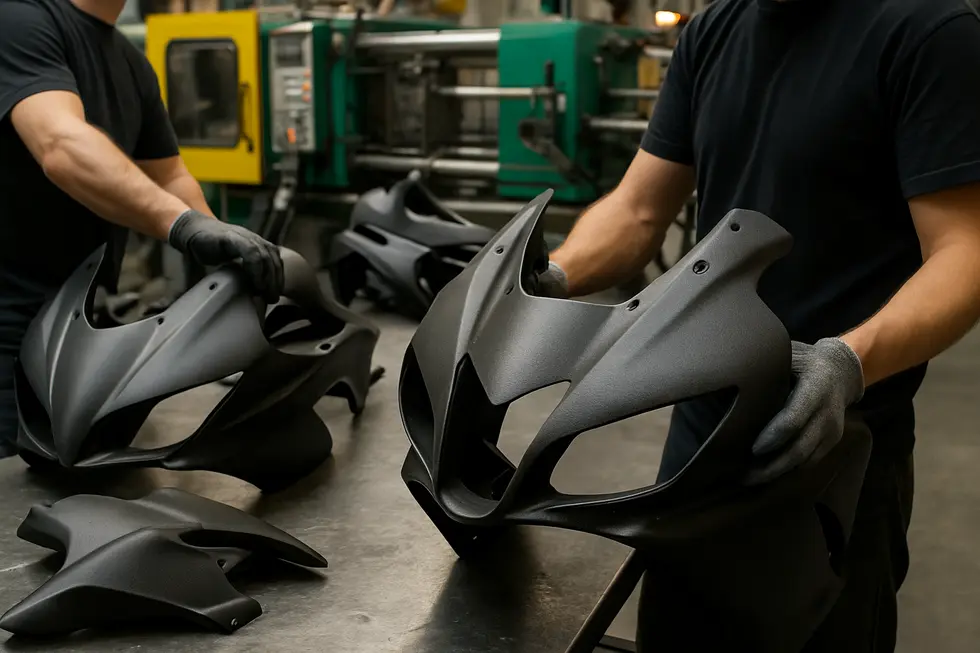
1. Choosing the Right Material: Balancing Strength, Weight, and Durability in Motorcycle Front Fairings
The selection of material for a motorcycle’s front fairing is a critical decision that directly shapes its performance, durability, and overall cost-effectiveness. Among common options, carbon fiber, fiberglass, and plastic stand out as the most prevalent choices, each offering distinct advantages tailored to different rider needs and bike types. Carbon fiber leads the way for high-performance motorcycles through its extraordinary strength-to-weight ratio. This material delivers outstanding stiffness and lightness, significantly reducing drag by up to 20%, which improves speed and fuel efficiency. Its premium qualities, however, come at a higher cost and require specialized manufacturing processes like vacuum bagging or autoclave curing to ensure both aesthetic finish and structural integrity. Fiberglass presents a solid middle ground, celebrated for its durability and budget-friendly nature. While heavier than carbon fiber, fiberglass still maintains strong resistance to impact and environmental wear, crafted through more accessible hand layup or spray-up methods that simplify production without compromising quality. Plastic, commonly ABS, tends to be the most affordable and easy to produce on a large scale. Lightweight and versatile, plastic fairings often serve mass-market motorcycles but generally lack the durability and high-end performance properties found in fiberglass or carbon fiber. Besides these material characteristics, manufacturers also incorporate multi-layer paint techniques and precision molding to ensure a seamless fit and an appealing finish, catering to both the functional and stylistic demands riders expect. Understanding these material choices is essential, as they influence not only the front fairing’s ability to reduce drag and protect the rider but also affect the motorcycle’s handling and long-term resilience. For a more comprehensive exploration of motorcycle fairing options and materials, visit explore the best motorcycle fairings at Summit Fairings.
External resource providing insight into carbon fiber manufacturing: Alibaba – Customized colors carbon fiber MIO sporty
2. Precision Injection Molding: Crafting Durable and Aerodynamic Motorcycle Front Fairings
The front fairing of a motorcycle owes much of its durability, aerodynamic precision, and visual appeal to high-grade ABS plastic formed through advanced injection molding techniques. This process begins with melting ABS plastic, which is then injected into meticulously designed molds that replicate the intricate shapes of fairing components. Such precision ensures that each piece achieves exact OEM specifications, delivering an ideal fit that integrates seamlessly with the motorcycle frame while providing the strength to withstand mechanical stresses and environmental exposure encountered during riding.
Automation plays a vital role in injection molding, securing consistency and efficiency throughout production. The repeatability of this method means that every fairing produced meets strict dimensional and quality standards essential for performance and longevity.
Following the molding stage, a comprehensive finishing regimen enhances both function and aesthetics. Initially, surfaces are sanded smooth, then primed to create a flawless base. Multiple layers of high-quality paint follow, tailored to resist UV rays, moisture, and other weather elements that could degrade the fairing over time. Decals may be applied next, offering customization options, and the process concludes with several clear coats that preserve the color brilliance while adding a protective gloss.
Designs often incorporate pre-drilled holes for straightforward bolt-on assembly, facilitating easier installation or replacement. Depending on the bike model, manufacturers might include complementary components such as windscreens or heat shields, further elevating rider comfort and protection.
This combination of robust ABS plastic and precise injection molding produces front fairings that not only optimize aerodynamic efficiency but also exhibit lasting durability and striking finishes. For those interested in exploring the range of quality motorcycle fairings crafted through such refined manufacturing, the explore the best motorcycle fairings at Summit Fairings offers valuable insights.
3. The Art of Finishing: Painting and Coating Techniques Elevating Front Fairings
The finishing and painting phase is crucial in transforming molded ABS plastic front fairings into visually striking and durable components. After manufacturing the fairing parts through precision injection molding, which ensures a perfect OEM-quality fit and structural resilience, the surface preparation begins to guarantee an impeccable paint job. This starts with meticulous sanding to smooth out any imperfections, providing an ideal base for the subsequent steps.
Applying a primer coat follows, serving to enhance paint adhesion while creating a uniform surface tone. This crucial layer prevents peeling and extends the life of the topcoat. Multiple layers of high-quality paint are then applied carefully, allowing for even color distribution and depth of finish—whether in glossy sheen or matte texture, depending on the rider’s preference. Brand logos and intricate decals are positioned with precision during this stage to add customization and identity to the motorcycle’s aesthetic.
To seal and protect the paintwork, at least three layers of clear coat are meticulously sprayed on. This final step creates a glossy, abrasion-resistant surface able to withstand harsh weather, UV exposure, and road debris impacts that riders commonly face. The multi-layer clear coating not only preserves the vibrant colors but also enhances the fairing’s overall durability, maintaining its aesthetic appeal through long-term use.
Custom finishes and race-inspired designs are common, allowing riders to express personality while benefiting from professional-grade durability. This thorough finishing process ensures the front fairing achieves both functional excellence and showroom-quality appearance.
For more insights into professionally crafted fairings and their manufacturing standards, explore comprehensive details at Kings Motorcycle Fairings’ professional paint and molding processes here.
Additionally, enthusiasts seeking a broad range of motorcycle fairings can discover unmatched choices in motorcycle fairings to complement these high-quality finishes.
4. Advancing Sustainability: Eco-Friendly Materials and Circular Manufacturing in Motorcycle Front Fairings
The push towards sustainability in motorcycle front fairing materials and manufacturing reflects a growing demand for reduced environmental impact without compromising performance. Leading innovations focus on integrating recycled and bio-based plastics, lightweight design, and circular economy principles to foster eco-friendly production and material use.
Manufacturers now employ recycled resins, such as pre-consumer polypropylene sourced from manufacturing scraps, and recycled aluminum to lessen the dependence on virgin raw materials. This substitution reduces CO₂ emissions associated with extraction and processing. Bioengineered plastics, like durable bio-based polymers, are increasingly replacing traditional petroleum-based plastics, delivering equivalent durability and UV resistance while lowering environmental footprints.
A key element of sustainability is circular design, where materials from end-of-life automotive parts are repurposed to create front fairings. This approach minimizes waste and promotes the reuse of resources within the supply chain. Additionally, optimizing fairing designs for lightweight structure further reduces material consumption and enhances fuel efficiency by improving aerodynamics, which has a secondary environmental benefit during the motorcycle’s operational life.
Some manufacturers experiment with advanced sustainable materials such as recycled carbon fiber and natural fibers like flax, exploring innovative composites that blend performance with reduced ecological impact. In contrast, aftermarket fairings often still rely on conventional ABS plastics that lack these sustainable attributes.
Together, these strategies mark a significant transition in front fairing production, showing how sustainability can be balanced with the demands of durability and styling. The ongoing refinement of materials and circular manufacturing promotes a greener lifecycle, from production to end use. For riders and industry alike, this shift illustrates a commitment to environmental responsibility allied with technology and design.
Discover more about the variety and advancements in motorcycle fairings at Summit Fairings.
For an in-depth look at bio-based plastic integration in motorcycle components, refer to automotive sustainability initiatives detailed here: https://www.honda.co.jp/tech/innovation/material/durabio_e.html
5. Cutting-Edge Materials and Manufacturing Techniques Elevating Motorcycle Front Fairings
The evolution of front fairings in motorcycles increasingly hinges on breakthroughs in advanced materials and manufacturing methods that emphasize performance and durability while reducing weight. Among the most significant material innovations are lightweight composites such as carbon fiber and emerging ultra-lightweight impact-resistant fibers. These materials provide high strength-to-weight ratios that directly translate to improved handling, acceleration, and stability by minimizing the front-end mass without sacrificing structural integrity. Premium racing motorcycles benefit from these composites, which also contribute to enhanced aerodynamic contours necessary for high-speed precision.
On the manufacturing front, injection molding of durable plastics like ABS continues to dominate mass-market production, offering consistent quality, cost efficiency, and complex design capabilities. This method allows for pre-fabricated mounting holes and intricate shapes essential for seamless installation and aerodynamic optimization. Alongside these traditional techniques, rapid prototyping accelerates design iterations, facilitating customization and innovation at a faster pace.
Complementing material and molding advances are improvements in surface treatments such as UV-resistant coatings that increase longevity by protecting fairings from weather-induced wear without altering their aerodynamic performance. Additionally, modern finishing processes support customized aesthetics including tailored color schemes, decals, and integrated lighting elements, marrying function with rider expression.
This tiered approach ensures riders from casual street enthusiasts to competitive racers have access to front fairings that strike an ideal balance between affordability, durability, and high-performance features. Such material and process innovations reshape front fairings into precision-engineered components that optimize the rider’s experience through weight reduction, enhanced airflow, and enduring style. For those interested in exploring a variety of fairing options shaped by these advances, a comprehensive range is available at Summit Fairings.
Chapter 3: Rider Protection and Aesthetic Considerations of the Front Fairing on a Motorcycle
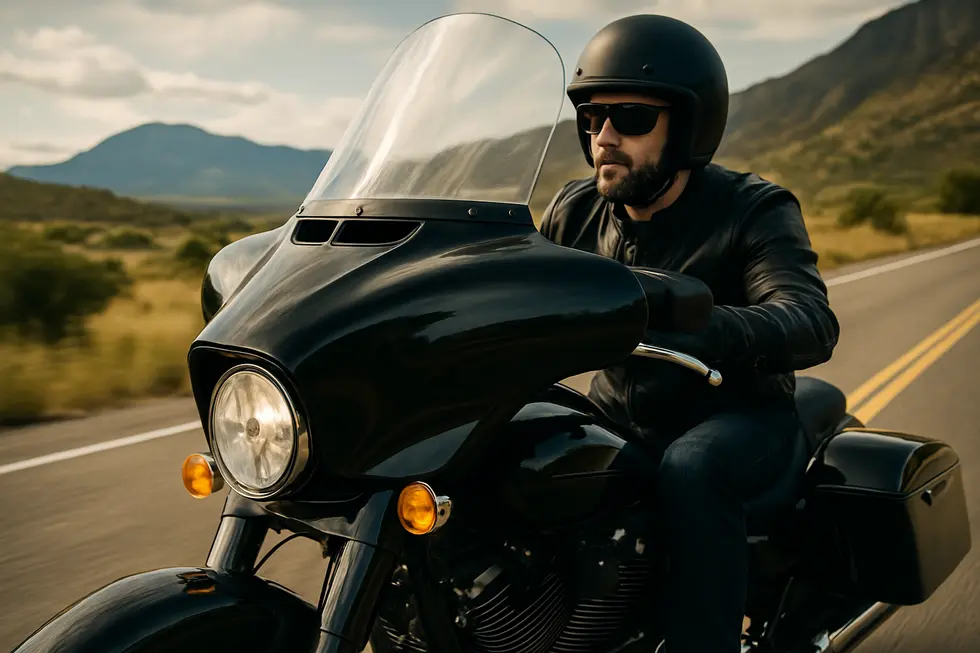
1. Cutting-Edge Rider Safety Features and Striking Front Fairing Designs Enhancing Protection and Style
Advancements in rider protection have shifted towards integrating technology that anticipates hazards and responds instantly, greatly enriching the safety landscape beyond traditional gear. Modern motorcycles now incorporate connected systems that transmit real-time alerts about road risks—including slippery conditions and traffic buildup—directly to the rider through smart helmets, augmented-reality glasses, and even haptic wristbands. These multi-sensory alerts significantly expand rider awareness, offering vital warning signals that surpass what unaided senses can detect. Complementing this, helmet-mounted rearview cameras paired with heads-up displays provide riders with an unobstructed wide-angle view behind them, eliminating blind spots and reducing the need for physical checks. Additionally, innovative protective equipment equipped with ultra-fast sensors can detect imminent collisions and deploy airbags around key areas like the chest and back within milliseconds, drastically minimizing injury in critical moments.
These safety strides coexist with equally sophisticated front fairing innovations that marry outstanding aerodynamic function with visually appealing design. Modern fairings are engineered not only to cut through air efficiently but also to generate downforce that stabilizes the motorcycle during high-speed or crosswind conditions. For instance, certain race-inspired designs embed winglets within the fairing to improve grip and engine cooling—features that, while technical, are thoughtfully concealed or styled to maintain an elegant appearance suited for street riding. Different motorcycle types reflect their priorities in fairing aesthetics: touring bikes offer varied front fairing styles such as handlebar-attached batwing fairings, which move dynamically with steering, or frame-mounted sharknose fairings that remain fixed for superior wind protection and fatigue reduction on long trips.
Together, these technological and design developments push the front fairing beyond its traditional role. It now functions as a critical safety interface that enhances hazard response and rider comfort while delivering distinct visual identity tailored to diverse riding needs. For those interested in exploring more about motorcycle fairings that blend functionality with style, a compelling resource is available at Explore the best motorcycle fairings at Summit Fairings.
For further insight into aerodynamic and aesthetic considerations blending perfectly, see detailed design innovations that also improve cooling and handling at speed here.
2. Innovative Materials and Engineering Techniques Shaping Rider Safety and Style in Front Fairings
The front fairing on a motorcycle plays a pivotal role in safeguarding the rider while defining the bike’s visual character. Advanced materials such as carbon fiber and fiberglass dominate fairing construction due to their unique balance of strength, weight, and formability. Carbon fiber, prized in sport and racing motorcycles, offers exceptional lightweight strength—approximately half the weight of steel—ensuring enhanced speed and fuel efficiency. Its superb aerodynamic shaping capability reduces drag by around 20%, creating sleek contours that slice through the air and contribute to rider protection by minimizing wind fatigue and turbulence. However, the premium cost and complex installation weigh against its widespread use.
Fiberglass, a staple in touring and cruiser fairings, excels through durability and repairability. Though heavier than carbon fiber, its robustness and glossy finish make it amenable to custom paint and styling, contributing to the motorcycle’s identity while offering dependable impact resistance. Designs often integrate impact-resistant acrylic windshields, delivering further shield against debris and weather, important for long-haul comfort.
Engineering the fairing involves sculpting airflow to generate a serene “bubble” of calm air enveloping the rider. Innovations like integrated winglets not only add aerodynamic downforce for improved high-speed stability but also facilitate crucial engine cooling. Mounting systems vary to optimize rider experience—handlebar-mounted fairings move with steering inputs enhancing control feel, while frame-mounted styles remain fixed, reducing rider fatigue through consistent wind deflection.
Beyond protection, front fairings serve as aesthetic canvases. They conceal mechanical components while maintaining fluid lines that echo brand heritage and modern performance. Custom color options and finishes allow riders to tailor their motorcycle’s look without sacrificing safety or aerodynamic efficiency. Exploring a diverse range of fairings and styles is key to finding the perfect balance between form and function, as highlighted by dedicated sources like Summit Fairings.
For comprehensive insights into carbon fiber applications in aerodynamic fairings, reference the detailed analysis at Alibaba.
3. How Aerodynamics Shapes Rider Safety and Visual Identity in Motorcycle Front Fairings
The aerodynamic design of a motorcycle’s front fairing is a vital synergy of form and function, directly impacting rider protection and the bike’s visual character. By strategically channeling airflow, the fairing significantly reduces drag, enhancing speed and stability, while creating a protective bubble that shields the rider from harsh wind and road debris. This airflow management not only improves performance but also lessens rider fatigue by moderating wind pressure over long or high-speed rides.
Different mounting approaches, such as handlebar-mounted versus frame-mounted fairings, influence how effectively air is deflected around the rider. Frame-mounted fairings tend to provide steadier wind protection, especially on highways, helping to maintain rider comfort and control without introducing additional turbulence from fairing movement. Aerodynamic features like integrated winglets generate downforce, pressing the motorcycle towards the road for improved grip and handling during high-speed maneuvers, subtly enhancing rider confidence and safety.
Beyond utility, the design of the front fairing must respect the motorcycle’s aesthetic appeal. The smooth contours and carefully balanced lines include functional vents and airflow channels that do not compromise visual harmony. While some aerodynamic elements may appear aggressive or race-inspired, they contribute to a distinct style that echoes the bike’s intended use, whether for competition, touring, or urban cruising. This balance between aerodynamic efficiency and design elegance ensures the front fairing is both a protective shield and a defining visual statement.
Ultimately, the front fairing exemplifies how aerodynamic expertise enriches rider comfort and safety while reinforcing the bike’s personality. By harmonizing air management with thoughtful styling, the fairing elevates both the practical and emotional experience of motorcycling.
For further exploration of diverse and well-crafted front fairing options reflecting this balance, see Explore the Best Motorcycle Fairings at Summit Fairings.
External resource: Ducati Panigale V4 aerodynamic and aesthetic design insights can be found at https://livingwithgravity.com/red-dot-if-award-winning-new-panigale-v4-ducatis-design-mastery/
4. Market Dynamics Shaping Rider Safety and Style in Motorcycle Front Fairings
Economic and consumer trends in 2025 profoundly influence how motorcycle front fairings evolve to enhance both rider protection and aesthetic appeal. Despite an overall decline in U.S. motorcycle sales by 9.2% early in the year due to inflation and cautious spending, leading manufacturers demonstrate that smart design strategies can capture market share by addressing rider needs effectively. Front fairings now integrate advanced materials like carbon fiber, improving durability and reducing weight while enhancing protection from wind, debris, and weather. These innovations respond to rising consumer demand for safety features that do not compromise a bike’s visual impact.
Designers closely consider riding styles—from aggressive sport postures to relaxed cruisers—to tailor fairing shapes that optimize ergonomic comfort and wind deflection. This attention to posture-specific aerodynamics blends seamlessly with evolving aesthetic preferences. The current style landscape fuses retro cues and modern elements, exemplified by semi-fairings on cafe racer models that evoke vintage motorcycling while delivering contemporary performance and protection. Such designs not only protect but also reinforce brand identity, providing a distinctive, lifestyle-oriented appeal.
Customization plays a pivotal role, with riders increasingly seeking flexible options to balance comfort, safety, and personal style. Fairings thus become more than functional components; they represent a key branding and differentiation tool that supports premium pricing. By merging the demands of protection and fashion, manufacturers maintain relevance amid economic pressures while satisfying a diverse and style-conscious market.
For those interested in exploring variety and customization options further, discover unmatched choices in motorcycle fairings at Summit Fairings.
External insights into the broader motorcycle market trends can be found at the United States Motorcycles Market Data & Insight 2025.
5. How Cultural Identity and Societal Norms Shape Front Fairing Design and Rider Protection
How Cultural Identity and Societal Norms Shape Front Fairing Design and Rider Protection
The design of a motorcycle’s front fairing is deeply influenced by cultural identities and societal factors that extend beyond pure functionality. Various motorcycle subcultures, such as Café racers, Choppers, and Streetfighters, have shaped the aesthetic language manufacturers embrace. These styles often symbolize values like rebellion, heritage, or individuality, guiding the visual elements of front fairings and sometimes prioritizing style over aerodynamic efficiency or protective features. This cultural influence ensures that front fairings are not merely functional parts but also embodiments of rider identity.
Beyond aesthetics, the cultural appreciation for performance and innovation often converges with protective design. Sophisticated fairings aim to create calm airflow zones around riders, mitigating fatigue and shielding them from environmental stressors. For example, leveraging racing technologies in street motorcycles reflects a blend of heritage and forward-thinking design sensibilities valued within motorcycle communities.
Regional societal contexts further shape how protection and styling coexist. Legal restrictions and social attitudes towards motorcycling—such as those affecting motorcycle use and rider demographics in certain countries—impact design priorities. In some regions, safety concerns or cultural norms may reduce emphasis on elaborate fairings, while in others, customization trends drive unique blends of style and function.
Custom culture thrives on personalization, allowing riders to reflect their values through tailored fairings that enhance both appearance and rider comfort. This personalization highlights how cultural expression and practical protection are intertwined, with accessories that simultaneously serve aesthetic and safety purposes.
The broader social perception of motorcycles as symbols of status or “coolness” further influences rider preferences. This tension between aesthetics and protection underscores the cultural complexities embedded in front fairing design, making it both a shield and a statement.
For those seeking personalized front fairings that balance these cultural and protective demands, exploring an extensive selection of styles and materials can offer options that truly resonate with individual rider identities and needs.https://blog.summitfairings.com/explore-summit-fairings-your-go-to-destination-for-motorcycle-fairings/
External Reference: [1]
Final thoughts
Understanding the multifaceted role of front fairings on motorcycles equips business owners with the insights needed to optimize product offerings and drive customer value. Aerodynamically, these components reduce drag, enhancing speed, stability, and fuel efficiency, particularly for performance-focused markets. The choice of advanced materials like ABS plastic paired with precise manufacturing techniques ensures durability and a high-quality fit, which are indispensable to consumer satisfaction. Furthermore, front fairings provide vital rider protection and an aesthetic canvas that influences buying decisions and brand attachment. Recognizing and integrating these aspects into business strategies can unlock growth, strengthen competitive positioning, and meet the evolving needs of motorcycle enthusiasts worldwide.
Ready to elevate your ride? Summit Fairings delivers premium, custom-fit fairings that blend style and durability. Whether you’re chasing speed or turning heads, we’ve got your bike covered. Don’t wait—transform your machine today. Click, customize, and ride with confidence. Your perfect fairing is just a few clicks away. Act now!
About us
We are one of the leading motorcycle fairing export sites, with over 3,000 styles across almost all motorcycle models. Buy from summitfairings.com, and pay 10-40% less than the prices on other sites. If you have any questions, we promise we will have your answer within six hours.
RELATED POSTS
View all

